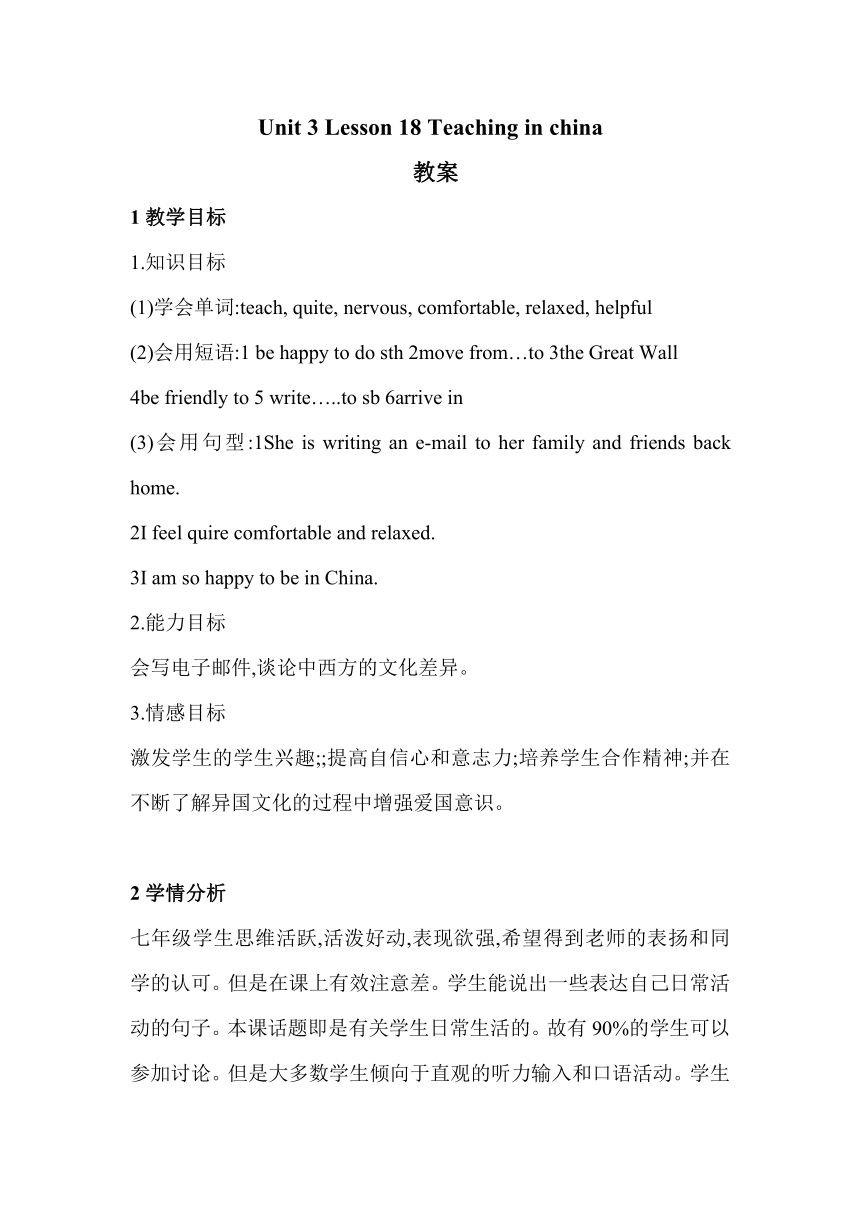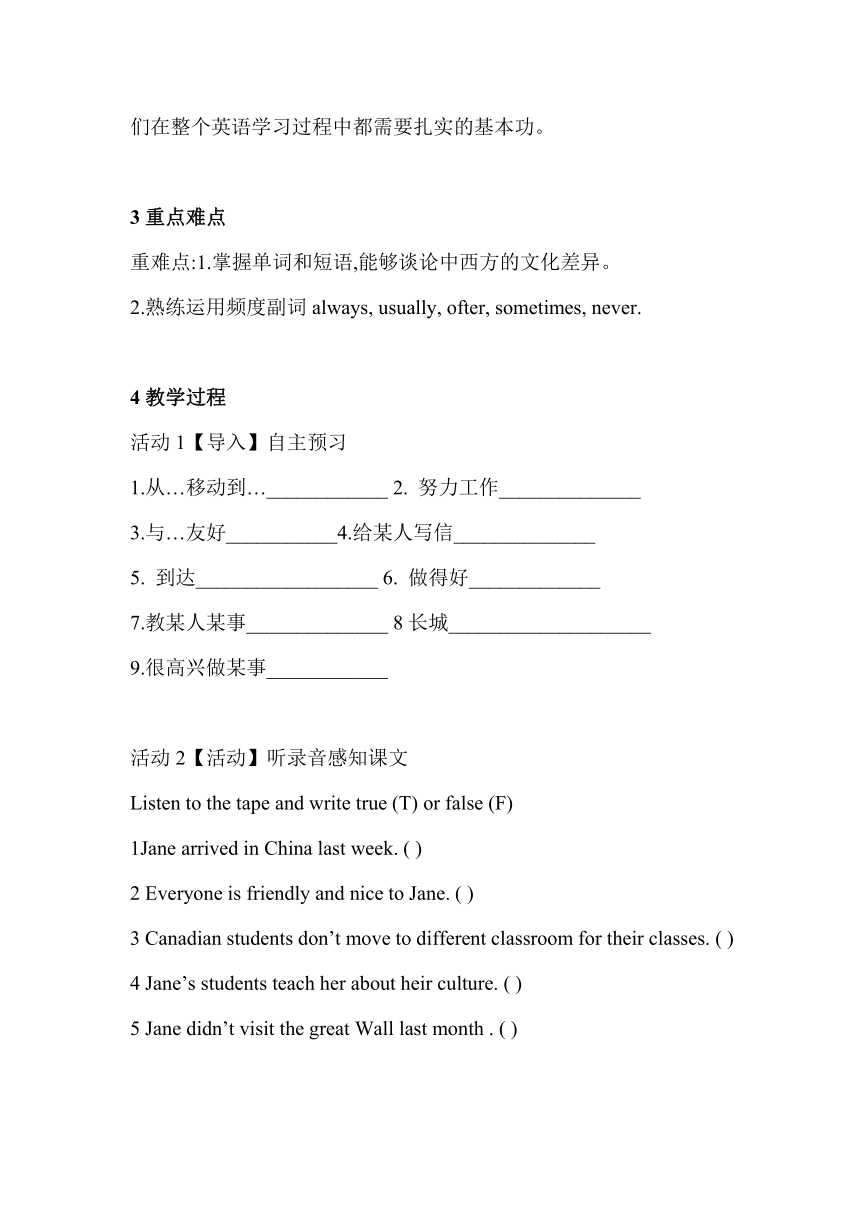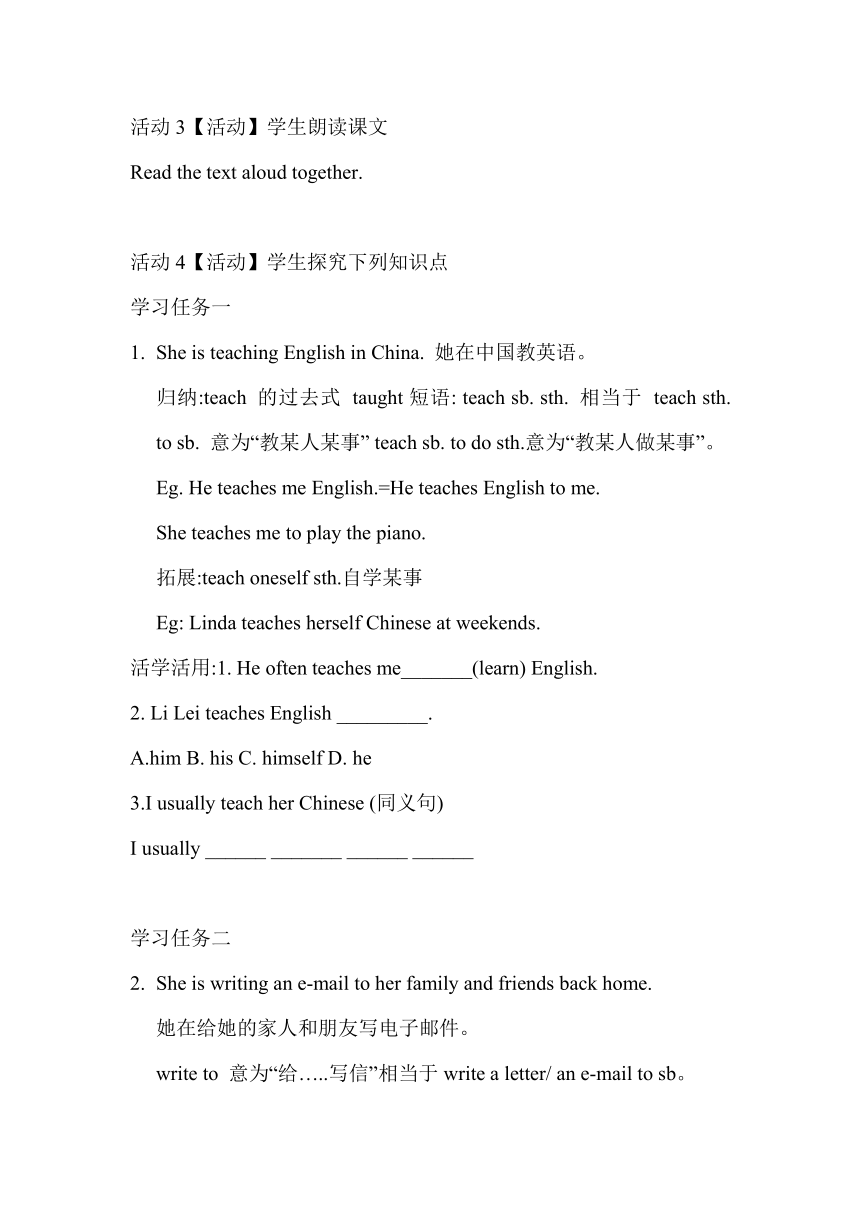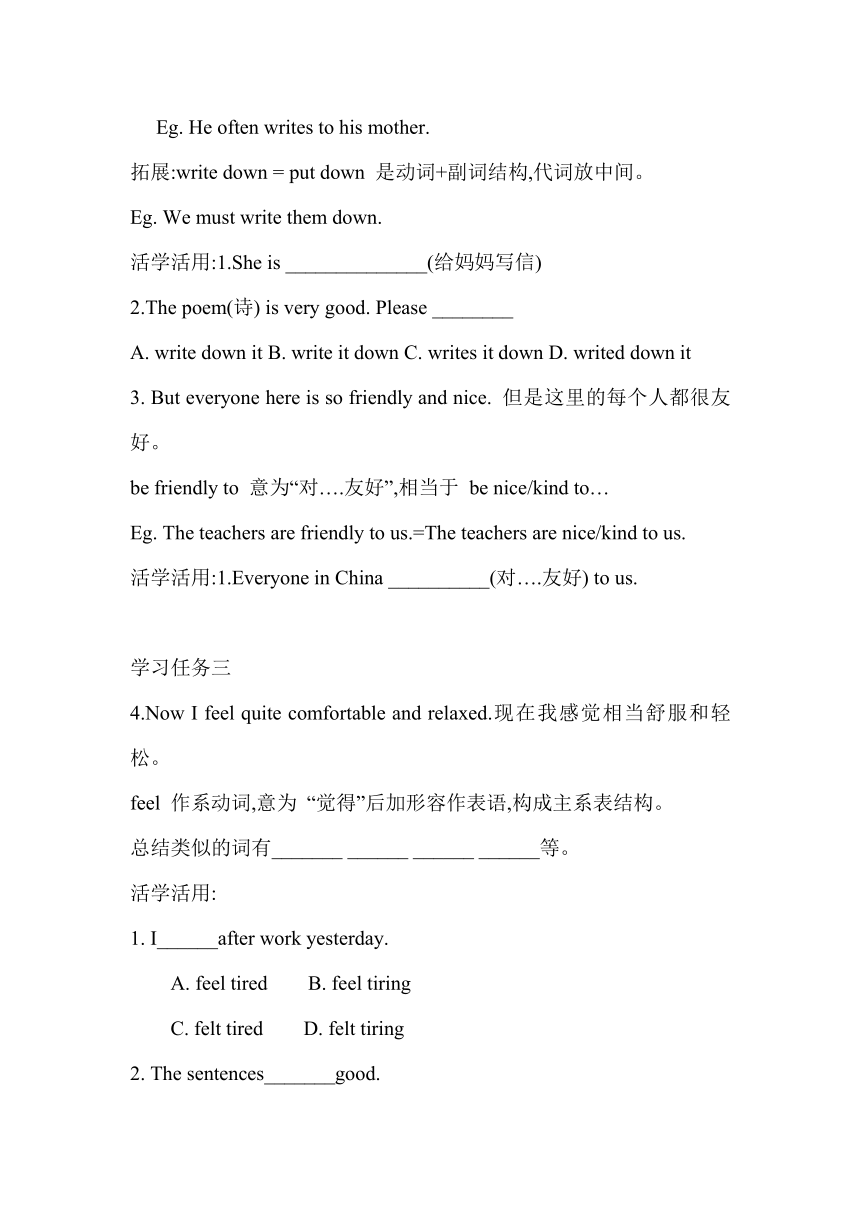Unit 3 Lesson 18 Teaching in china 教案
文档属性
| 名称 | Unit 3 Lesson 18 Teaching in china 教案 |  | |
| 格式 | zip | ||
| 文件大小 | 121.9KB | ||
| 资源类型 | 教案 | ||
| 版本资源 | 冀教版 | ||
| 科目 | 英语 | ||
| 更新时间 | 2017-02-16 19:00:07 | ||
图片预览




文档简介
Unit
3
Lesson
18
Teaching
in
china
教案
1教学目标
1.知识目标
(1)学会单词:teach,
quite,
nervous,
comfortable,
relaxed,
helpful
(2)会用短语:1
be
happy
to
do
sth
2move
from…to
3the
Great
Wall
4be
friendly
to
5
write…..to
sb
6arrive
in
(3)会用句型:1She
is
writing
an
e-mail
to
her
family
and
friends
back
home.
2I
feel
quire
comfortable
and
relaxed.
3I
am
so
happy
to
be
in
China.
2.能力目标
会写电子邮件,谈论中西方的文化差异。
3.情感目标
激发学生的学生兴趣;;提高自信心和意志力;培养学生合作精神;并在不断了解异国文化的过程中增强爱国意识。
2学情分析
七年级学生思维活跃,活泼好动,表现欲强,希望得到老师的表扬和同学的认可。但是在课上有效注意差。学生能说出一些表达自己日常活动的句子。本课话题即是有关学生日常生活的。故有90%的学生可以参加讨论。但是大多数学生倾向于直观的听力输入和口语活动。学生们在整个英语学习过程中都需要扎实的基本功。
3重点难点
重难点:1.掌握单词和短语,能够谈论中西方的文化差异。
2.熟练运用频度副词always,
usually,
ofter,
sometimes,
never.
4教学过程
活动1【导入】自主预习
1.从…移动到…____________
2.
努力工作______________
3.与…友好___________4.给某人写信______________
5.
到达__________________
6.
做得好_____________
7.教某人某事______________
8长城____________________
9.很高兴做某事____________
活动2【活动】听录音感知课文
Listen
to
the
tape
and
write
true
(T)
or
false
(F)
1Jane
arrived
in
China
last
week.
(
)
2
Everyone
is
friendly
and
nice
to
Jane.
(
)
3
Canadian
students
don’t
move
to
different
classroom
for
their
classes.
(
)
4
Jane’s
students
teach
her
about
heir
culture.
(
)
5
Jane
didn’t
visit
the
great
Wall
last
month
.
(
)
活动3【活动】学生朗读课文
Read
the
text
aloud
together.
活动4【活动】学生探究下列知识点
学习任务一
She
is
teaching
English
in
China.
她在中国教英语。
归纳:teach
的过去式
taught短语:
teach
sb.
sth.
相当于
teach
sth.
to
sb.
意为“教某人某事”
teach
sb.
to
do
sth.意为“教某人做某事”。
Eg.
He
teaches
me
English.=He
teaches
English
to
me.
She
teaches
me
to
play
the
piano.
拓展:teach
oneself
sth.自学某事
Eg:
Linda
teaches
herself
Chinese
at
weekends.
活学活用:1.
He
often
teaches
me_______(learn)
English.
2.
Li
Lei
teaches
English
_________.
A.him
B.
his
C.
himself
D.
he
3.I
usually
teach
her
Chinese
(同义句)
I
usually
______
_______
______
______
学习任务二
She
is
writing
an
e-mail
to
her
family
and
friends
back
home.
她在给她的家人和朋友写电子邮件。
write
to
意为“给…..写信”相当于write
a
letter/
an
e-mail
to
sb。
Eg.
He
often
writes
to
his
mother.
拓展:write
down
=
put
down
是动词+副词结构,代词放中间。
Eg.
We
must
write
them
down.
活学活用:1.She
is
______________(给妈妈写信)
2.The
poem(诗)
is
very
good.
Please
________
A.
write
down
it
B.
write
it
down
C.
writes
it
down
D.
writed
down
it
3.
But
everyone
here
is
so
friendly
and
nice.
但是这里的每个人都很友好。
be
friendly
to
意为“对….友好”,相当于
be
nice/kind
to…
Eg.
The
teachers
are
friendly
to
us.=The
teachers
are
nice/kind
to
us.
活学活用:1.Everyone
in
China
__________(对….友好)
to
us.
学习任务三
4.Now
I
feel
quite
comfortable
and
relaxed.现在我感觉相当舒服和轻松。
feel
作系动词,意为
“觉得”后加形容作表语,构成主系表结构。
总结类似的词有_______
______
______
______等。
活学活用:
1.
I______after
work
yesterday.
A.
feel
tired
B.
feel
tiring
C.
felt
tired
D.
felt
tiring
2.
The
sentences_______good.
A.
look
B.
taste
C.
smell
D.
sound
3.
The
food________delicious.
A.
looks
B.
tastes
C.
smells
D.s
ounds
学习任务四
语法:频度副词用来表示动作或状态发生的频率。
英语中常见的频度副词及发生频率的高低为:always
(总是,一直)
usually(通常)
often(经常)sometimes(有时)never(从不,决不),它们在句中位于实义动词之前,be动词、情态动词、助动词之后,简单记住:“行前be、情、助后“
记住:how
often用来对某动作或状态发生的频率进行提问。
Eg:-----
How
often
does
Danny
eat
donuts ------Always
活学活用:
用所给词的适当形式填空
[always
,
often,
usually,
sometimes,
never,
how
often]
1
He
is
too
busy.
He
_________watches
TV.
2
Li
Lei
very
kind
and
________ready
to
help
others.
3
What
time
do
you
________get
up
4
——_________do
you
play
computer
games
——
Once
a
week.
5
My
mother________goes
to
work
by
bike,but
________by
bus.
活动5【练习】仿写作文
Write
a
project
about
your
school
life
————————————————————————————————————————————————————————————————————————————————————————————————————————————————————————————————————————————————————————————————————————————————————————————————————————————————————————————————————————————————
活动6【练习】基础知识达标
I.根据句意和汉语提示完成单词。
1.The
teachers
are
always______________(有帮助的)
2.I
feel
____________(轻松的)at
home.
3.He
has
a
very
_____________(舒适的)home.
4.I
feel
___________(非常)well.
5.I
was
quite
______________(紧张的)then.
II.用所给词的适当形式填空
nervous.
friend.
relax.
wonderful.
teach
1.I
didn’t
know
anyone
at
the
party.
But
everyone
was
very__________.
2.Spring
is
nice
and
warm.
It
is
a
___________season.
3.Li
Ming
is
going
to
give
a
talk.
He
is
quite
_________.
4.She
is
a
_________.She
________music
at
a
middle
school.
5.After
a
busy
day,
I
like
to
sit
and
drink
a
cup
of
tea.
It
makes
me
feel_________.
活动7【测试】课堂小检测
III.单项选择
(
)
1.Mr.
Liu
is
friendly
____everyone
in
his
class.
A.
on
B.
to
C.at
D.
of
(
)
2.The
woman
teaches
______English
well.
A
.our
B.
we
C.
us
D.
ours
(
)
3.They
move_____classroom_____classroom
for
their
classes.
A
.between;
and
B.
between;
to
C.
from;
and
D.
from;
to
(
)
4.He
often
teaches
the
children_______the
piano.
A
.to
play
B.
play
C.to
playing
D.
playing
(
)
5.Look!
She
is
writing
_______e-mail.
a
B.
an
C.
the
D./
(
)
6.The
computer
s
are
really_________.We
use
them
everywhere.
comfortable
B.
nervous
C.
relaxed
D.
helpful
(
)
7.
He
______walks
to
school,
because
he
lives
near
school.
A.
usually
B.
never
C.
hardly
D.
seldom
(
)
8.
------How
often
do
you
play
basketball -----__________
Once
a
week
B.
One
week
In
a
week
D.
For
a
week
(
)
9.Look!
Jane
is
_______a
letter_______her
family.
writing;
to
B.
write;
for
C.
write;
to
D.
writing;
for
(
)
10.The
music
_________beautiful.
A.
looks
B.
tastes
C.
smells
D.
sounds
活动8【作业】能力提升
IV.完形填空
Bob
comes
from
America.
His
father
works
in
Beijing
so
his
family
come
to
(1)
.The
boy
is
studying
in
our
school.
He’s
only
fourteen,
but
he’s
(2)
.
So
he
sits
in
Row
Six.
Bod’s
father
has
a
(3)
,
but
Bob
comes
to
school
by
bus
or
by
bike.
Sometimes
he
(4)
there.
He
likes
(5)
football.
Bob
can
(6)
English
and
French.
And
he
knows
a
little
Chinese,
too.He
often
helps
Miss
Gate
(7)
us
English.
After
class
we
often
talk
in
English.
He
tells
us
something
about
his
country.
It’s
Mid-Autumn
Day
today.
After
(8)
I
invite
Bob
to
my
home
to
have
dinner.My
parents
give
him
a
lot
of
(9)
.
He
likes
them
very
much
and
eats
a
lot
.He
says
they
are
very
(10)
.
SO
we
give
him
some
mooncakes
and
ask
him
to
his
parents
before
he
leaves.
(
)
1.
A.
Canada
B.
America
C.
England
D.
China
(
)
2.
A.
long
B.
tall
C.
young
D.
old
(
)
3.
A.
car
B.
plane
C.
ship
D.
train
(
)
4.
A.
jumps
B.
sits
C.
walks
D.
stands
(
)
5.
A.
play
B.
playing
C.
plays
D.
played
(
)
6.
A.
say
B.
speak
C.
tell
D.
talk
(
)
7.
A.
ask
B.
make
C.
teach
D.
count
(
)
8.
A.
breakfast
B.
work
C.
lunch
D.
school
(
)
9.
A.
pumpkin
pies
B.
turkeys
C.
mooncakes
D.
books
3
Lesson
18
Teaching
in
china
教案
1教学目标
1.知识目标
(1)学会单词:teach,
quite,
nervous,
comfortable,
relaxed,
helpful
(2)会用短语:1
be
happy
to
do
sth
2move
from…to
3the
Great
Wall
4be
friendly
to
5
write…..to
sb
6arrive
in
(3)会用句型:1She
is
writing
an
to
her
family
and
friends
back
home.
2I
feel
quire
comfortable
and
relaxed.
3I
am
so
happy
to
be
in
China.
2.能力目标
会写电子邮件,谈论中西方的文化差异。
3.情感目标
激发学生的学生兴趣;;提高自信心和意志力;培养学生合作精神;并在不断了解异国文化的过程中增强爱国意识。
2学情分析
七年级学生思维活跃,活泼好动,表现欲强,希望得到老师的表扬和同学的认可。但是在课上有效注意差。学生能说出一些表达自己日常活动的句子。本课话题即是有关学生日常生活的。故有90%的学生可以参加讨论。但是大多数学生倾向于直观的听力输入和口语活动。学生们在整个英语学习过程中都需要扎实的基本功。
3重点难点
重难点:1.掌握单词和短语,能够谈论中西方的文化差异。
2.熟练运用频度副词always,
usually,
ofter,
sometimes,
never.
4教学过程
活动1【导入】自主预习
1.从…移动到…____________
2.
努力工作______________
3.与…友好___________4.给某人写信______________
5.
到达__________________
6.
做得好_____________
7.教某人某事______________
8长城____________________
9.很高兴做某事____________
活动2【活动】听录音感知课文
Listen
to
the
tape
and
write
true
(T)
or
false
(F)
1Jane
arrived
in
China
last
week.
(
)
2
Everyone
is
friendly
and
nice
to
Jane.
(
)
3
Canadian
students
don’t
move
to
different
classroom
for
their
classes.
(
)
4
Jane’s
students
teach
her
about
heir
culture.
(
)
5
Jane
didn’t
visit
the
great
Wall
last
month
.
(
)
活动3【活动】学生朗读课文
Read
the
text
aloud
together.
活动4【活动】学生探究下列知识点
学习任务一
She
is
teaching
English
in
China.
她在中国教英语。
归纳:teach
的过去式
taught短语:
teach
sb.
sth.
相当于
teach
sth.
to
sb.
意为“教某人某事”
teach
sb.
to
do
sth.意为“教某人做某事”。
Eg.
He
teaches
me
English.=He
teaches
English
to
me.
She
teaches
me
to
play
the
piano.
拓展:teach
oneself
sth.自学某事
Eg:
Linda
teaches
herself
Chinese
at
weekends.
活学活用:1.
He
often
teaches
me_______(learn)
English.
2.
Li
Lei
teaches
English
_________.
A.him
B.
his
C.
himself
D.
he
3.I
usually
teach
her
Chinese
(同义句)
I
usually
______
_______
______
______
学习任务二
She
is
writing
an
to
her
family
and
friends
back
home.
她在给她的家人和朋友写电子邮件。
write
to
意为“给…..写信”相当于write
a
letter/
an
to
sb。
Eg.
He
often
writes
to
his
mother.
拓展:write
down
=
put
down
是动词+副词结构,代词放中间。
Eg.
We
must
write
them
down.
活学活用:1.She
is
______________(给妈妈写信)
2.The
poem(诗)
is
very
good.
Please
________
A.
write
down
it
B.
write
it
down
C.
writes
it
down
D.
writed
down
it
3.
But
everyone
here
is
so
friendly
and
nice.
但是这里的每个人都很友好。
be
friendly
to
意为“对….友好”,相当于
be
nice/kind
to…
Eg.
The
teachers
are
friendly
to
us.=The
teachers
are
nice/kind
to
us.
活学活用:1.Everyone
in
China
__________(对….友好)
to
us.
学习任务三
4.Now
I
feel
quite
comfortable
and
relaxed.现在我感觉相当舒服和轻松。
feel
作系动词,意为
“觉得”后加形容作表语,构成主系表结构。
总结类似的词有_______
______
______
______等。
活学活用:
1.
I______after
work
yesterday.
A.
feel
tired
B.
feel
tiring
C.
felt
tired
D.
felt
tiring
2.
The
sentences_______good.
A.
look
B.
taste
C.
smell
D.
sound
3.
The
food________delicious.
A.
looks
B.
tastes
C.
smells
D.s
ounds
学习任务四
语法:频度副词用来表示动作或状态发生的频率。
英语中常见的频度副词及发生频率的高低为:always
(总是,一直)
usually(通常)
often(经常)sometimes(有时)never(从不,决不),它们在句中位于实义动词之前,be动词、情态动词、助动词之后,简单记住:“行前be、情、助后“
记住:how
often用来对某动作或状态发生的频率进行提问。
Eg:-----
How
often
does
Danny
eat
donuts ------Always
活学活用:
用所给词的适当形式填空
[always
,
often,
usually,
sometimes,
never,
how
often]
1
He
is
too
busy.
He
_________watches
TV.
2
Li
Lei
very
kind
and
________ready
to
help
others.
3
What
time
do
you
________get
up
4
——_________do
you
play
computer
games
——
Once
a
week.
5
My
mother________goes
to
work
by
bike,but
________by
bus.
活动5【练习】仿写作文
Write
a
project
about
your
school
life
————————————————————————————————————————————————————————————————————————————————————————————————————————————————————————————————————————————————————————————————————————————————————————————————————————————————————————————————————————————————
活动6【练习】基础知识达标
I.根据句意和汉语提示完成单词。
1.The
teachers
are
always______________(有帮助的)
2.I
feel
____________(轻松的)at
home.
3.He
has
a
very
_____________(舒适的)home.
4.I
feel
___________(非常)well.
5.I
was
quite
______________(紧张的)then.
II.用所给词的适当形式填空
nervous.
friend.
relax.
wonderful.
teach
1.I
didn’t
know
anyone
at
the
party.
But
everyone
was
very__________.
2.Spring
is
nice
and
warm.
It
is
a
___________season.
3.Li
Ming
is
going
to
give
a
talk.
He
is
quite
_________.
4.She
is
a
_________.She
________music
at
a
middle
school.
5.After
a
busy
day,
I
like
to
sit
and
drink
a
cup
of
tea.
It
makes
me
feel_________.
活动7【测试】课堂小检测
III.单项选择
(
)
1.Mr.
Liu
is
friendly
____everyone
in
his
class.
A.
on
B.
to
C.at
D.
of
(
)
2.The
woman
teaches
______English
well.
A
.our
B.
we
C.
us
D.
ours
(
)
3.They
move_____classroom_____classroom
for
their
classes.
A
.between;
and
B.
between;
to
C.
from;
and
D.
from;
to
(
)
4.He
often
teaches
the
children_______the
piano.
A
.to
play
B.
play
C.to
playing
D.
playing
(
)
5.Look!
She
is
writing
_______e-mail.
a
B.
an
C.
the
D./
(
)
6.The
computer
s
are
really_________.We
use
them
everywhere.
comfortable
B.
nervous
C.
relaxed
D.
helpful
(
)
7.
He
______walks
to
school,
because
he
lives
near
school.
A.
usually
B.
never
C.
hardly
D.
seldom
(
)
8.
------How
often
do
you
play
basketball -----__________
Once
a
week
B.
One
week
In
a
week
D.
For
a
week
(
)
9.Look!
Jane
is
_______a
letter_______her
family.
writing;
to
B.
write;
for
C.
write;
to
D.
writing;
for
(
)
10.The
music
_________beautiful.
A.
looks
B.
tastes
C.
smells
D.
sounds
活动8【作业】能力提升
IV.完形填空
Bob
comes
from
America.
His
father
works
in
Beijing
so
his
family
come
to
(1)
.The
boy
is
studying
in
our
school.
He’s
only
fourteen,
but
he’s
(2)
.
So
he
sits
in
Row
Six.
Bod’s
father
has
a
(3)
,
but
Bob
comes
to
school
by
bus
or
by
bike.
Sometimes
he
(4)
there.
He
likes
(5)
football.
Bob
can
(6)
English
and
French.
And
he
knows
a
little
Chinese,
too.He
often
helps
Miss
Gate
(7)
us
English.
After
class
we
often
talk
in
English.
He
tells
us
something
about
his
country.
It’s
Mid-Autumn
Day
today.
After
(8)
I
invite
Bob
to
my
home
to
have
dinner.My
parents
give
him
a
lot
of
(9)
.
He
likes
them
very
much
and
eats
a
lot
.He
says
they
are
very
(10)
.
SO
we
give
him
some
mooncakes
and
ask
him
to
his
parents
before
he
leaves.
(
)
1.
A.
Canada
B.
America
C.
England
D.
China
(
)
2.
A.
long
B.
tall
C.
young
D.
old
(
)
3.
A.
car
B.
plane
C.
ship
D.
train
(
)
4.
A.
jumps
B.
sits
C.
walks
D.
stands
(
)
5.
A.
play
B.
playing
C.
plays
D.
played
(
)
6.
A.
say
B.
speak
C.
tell
D.
talk
(
)
7.
A.
ask
B.
make
C.
teach
D.
count
(
)
8.
A.
breakfast
B.
work
C.
lunch
D.
school
(
)
9.
A.
pumpkin
pies
B.
turkeys
C.
mooncakes
D.
books
同课章节目录
- Unit 1 A Trip to the Silk Road
- Lesson 1 A Trip to China
- Lesson 2 Meet You in Beijing
- Lesson 3 A Visit to Xi'an
- Lesson 4 A Visit to Lanzhou
- Lesson 5 Another Stop along the Silk Road
- Lesson 6 Jenny's Diary
- Unit 2 It's Show Time!
- Lesson 7 What's Your Project about?
- Lesson 8 Marco Polo and the Silk Road
- Lesson 9 Danny's School Project
- Lesson 10 Music and Dance
- Lesson 11 Food in China
- Lesson 12 A Blog about the Silk Road
- Unit 3 School Life
- Lesson 13 How Is School Going?
- Lesson 14 Jenny's School Life
- Lesson 15 Making a Difference
- Lesson 16 We Are with You!
- Lesson 17 School Science Fai
- Lesson 18 Teaching in China
- Unit 4 After-School Activities
- Lesson 19 A Dinner Date
- Lesson 20 Join Our Club!
- Lesson 21 What Is Your Club Type?
- Lesson 22 Big Plans for the Weekend
- Lesson 23 A Weekend with Grandma
- Lesson 24 How was Your Weekend?
- Unit 5 I Love Learning English!
- Lesson 25 A Phone Friend
- Lesson 26 Online Phone Calls
- Lesson 27 Amazing English
- Lesson 28 How Do I Learn English?
- Lesson 29 A Door to the World
- Lesson 30 Writing an E-mail in English
- Unit 6 Seasons
- Lesson 31 What Strange Weather!
- Lesson 32 I Can't Wait for Winter!
- Lesson 33 Kim's Favourite Season
- Lesson 34 Steven's Report
- Lesson 35 Surfing in Sydney
- Lesson 36 Spring in China
- Unit 7 Sports and Good Health
- Lesson 37 You Are What You Eat!
- Lesson 38 Stay Healthy!
- Lesson 39 Danny's Report
- Lesson 40 Move Your Body
- Lesson 41 Were People Healthy Then?
- Lesson 42 Know Yourself
- Unit 8 Summer Holiday Is Coming!
- Lesson 43 Have a Good Summer!
- Lesson 44 Volunteering in Summe
- Lesson 45 Baseball Season
- Lesson 46 Get Ready for Summer Holiday!
- Lesson 47 Summer Plans
- Lesson 48 Li Ming's Summer Holiday
